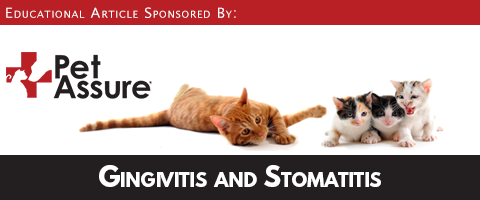Gingivostomatitis
Two mouth diseases in cats that commonly come together are:
- Gingivitis: inflammation of the gums
- Stomatitis: inflammation of the entire mouth, including the tongue, inner lips, floor and roof of the mouth
Bacteria build-up on the teeth can enter your pet’s bloodstream and infect other organs. If left untreated, it will lead to tooth loss.
Gingivostomatitis is treatable and preventable. Regular dental care, at home and by your veterinarian, is necessary for your pet to have good dental health.
There is no successful medical treatment for Stomatitis. The inflammation can be hidden with antibiotics, vitamins, probiotics etc., however, none are truly effective in the long term. Most often the pain relief is short-lived while on these medicines and discomfort quickly returns.
CAUSES:
There are no proven causes, but some theories include:
- Diseases that suppresses the immune system
- Poor oral hygiene
- Feline Leukemia Virus (FeLV)
- Feline Immunodeficiency virus (FIV)
- Metabolic disorders
- Kidney failure
- Diabetes
- Bacterial or fungal infections
- Trauma to the face or mouth
- Cancer
- Chemotherapy or radiation therapy
SIGNS:
Obvious signs that your cat has developed gingivitis and stomatitis are:
- Severe inflammation where the teeth meet the gums
- Severe pain: this can cause behavioral change, including irritability, aggressiveness, depression
- Excessive drooling
- Difficulty eating and weight loss
- Bad breath
- Inadequate grooming
- Bumpy gums which bleed easily
- Dehydration
- Anorexia
- Aggressiveness
DIAGNOSIS:
In order to properly diagnose your cat with gingivitis and stomatitis, your veterinarian may perform the following:
- Physical exam: teeth and gums
- Dental x-rays
- Blood and urine tests: to look for underlying diseases
- A deep biopsy
TREATMENT:
Most veterinarians will recommend the following treatments for cats with gingivostomatitis:
- Dental cleaning: using anesthesia, ultrasonic scaling and polishing tools
- Dental surgery: to remove badly affected teeth
- Oral antibiotics
You will not be able to remove the plaque and tartar yourself, because:
- Tartar can reside below the gumline and continue causing problems, and you can only remove tartar above the gumline
- It’s unsafe to clean the inner parts of the teeth while your pet is conscious
- Using dental instruments may scratch your pet’s teeth, which will cause further damage. Your veterinarian will polish your pet’s teeth to prevent this
PREVENTION:
- Annual oral exams
- Brush your pet’s teeth daily with toothpaste made for pets only! Human toothpaste contains ingredients that are toxic for pets. It is crucial to brush your pet’s teeth on a daily basis as plaque and tartar can begin accumulating in just six hours after a dental cleaning. Your veterinarian will instruct you how to brush pet’s teeth
- Your veterinarian can design a prescription dental diet to remove plaque as your pet chews
- You can add gels and liquid products to the drinking water
- Give your pet special chew toys which are designed to reduce tartar
PROGNOSIS:
The prognosis depends on the underlying cause. In simple cases, the prognosis is excellent with professional dental cleaning and home care.



